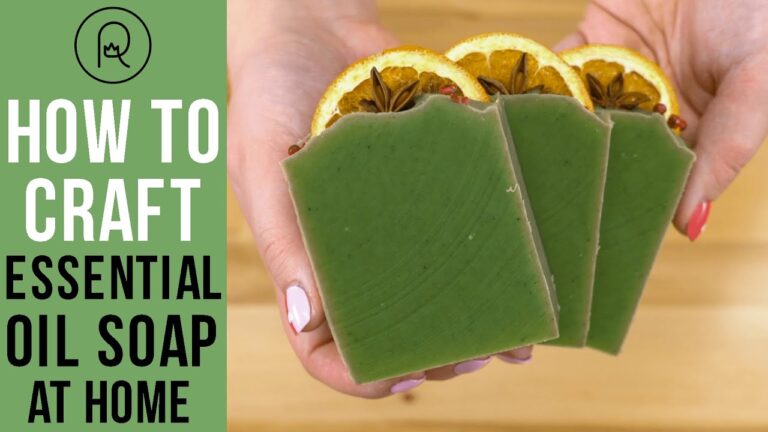Are you tired of using soap that irritates your skin? Look no further! In this article, we will explore the world of allergy-conscious soap making techniques. From using natural ingredients to avoiding common allergens, we’ll show you how to create gentle and effective soaps that everyone can enjoy. Whether you have sensitive skin or simply want to be more mindful of the products you use, these techniques are sure to revolutionize your soap making experience. Say goodbye to itchy, irritated skin and hello to a new era of clean, healthy, and allergy-conscious soap!
What are the 4 methods of making soap?
Discover the art of soap making with these four unique methods: cold process, melt and pour, hot process, and rebatch. Each technique offers its own charm and creativity, allowing you to customize your soap to perfection. Whether you prefer the traditional cold process or the convenience of melt and pour, there’s a method for everyone to enjoy the craft of soap making.
Unleash your creativity and dive into the world of soap making with these four versatile methods. From the precise control of the cold process to the rustic charm of rebatch, there’s a technique to suit every soap maker’s preferences. Experiment, explore, and create your own signature soap with these diverse methods at your fingertips.
What causes allergies in soap?
Sodium Lauryl Sulfate (SLS) is a common ingredient in soap that can trigger allergies. It is a detergent found in bar soaps and liquid hand soap, known for causing allergic reactions and skin irritation. Individuals with sensitive skin or those prone to skin conditions like eczema or psoriasis should avoid products containing SLS to prevent adverse reactions.
What ingredients are in hypoallergenic soap?
Hypoallergenic soap is formulated with gentle, non-irritating ingredients that are less likely to cause allergic reactions. Common ingredients include natural oils such as coconut, olive, or almond oil, as well as soothing ingredients like aloe vera and chamomile. These gentle ingredients help to cleanse the skin without stripping away its natural oils, making hypoallergenic soap suitable for those with sensitive skin or allergies.
In addition, hypoallergenic soap often excludes harsh chemicals and fragrances that can trigger allergic reactions. Instead, it may contain natural or plant-based ingredients that are free from potential allergens. By using hypoallergenic soap, individuals can enjoy a gentle and effective cleansing experience without the worry of skin irritation or allergic reactions.
Gentle Soap Crafting for Sensitive Skin
Crafting gentle soap for sensitive skin requires a delicate balance of nourishing ingredients and soothing scents. Our handmade soaps are meticulously crafted with natural oils and butters to cleanse without stripping the skin of its natural oils, leaving your skin feeling soft and hydrated. With gentle formulas free of harsh chemicals and artificial fragrances, our soaps are perfect for those with sensitive skin who are looking for a gentle and effective cleansing experience. Treat your skin to the luxury it deserves with our gentle soap crafted with care.
Allergy-Friendly Soap Making Tips
Looking to create allergy-friendly soap? Start by choosing gentle, hypoallergenic ingredients such as shea butter, coconut oil, and oatmeal to avoid common allergens. Be sure to avoid fragrances, dyes, and harsh chemicals that can irritate sensitive skin. Additionally, consider using natural colorants like turmeric or spirulina for a beautiful, skin-safe product. By following these tips, you can create a soothing and safe soap that is perfect for those with allergies.
Sensitive Skin Soap Crafting Guide
Discover the art of crafting gentle and nourishing soap for sensitive skin with our comprehensive guide. From selecting the right ingredients to mastering the perfect blend, this guide will take you through each step of the soap-making process. Say goodbye to harsh chemicals and irritants, and hello to a soothing and luxurious cleansing experience tailored specifically for sensitive skin.
Elevate your skincare routine with handmade soap that is as gentle on your skin as it is on the environment. With our expert tips and tricks, you can create custom soap bars that cater to your skin’s unique needs, leaving it feeling soft, smooth, and rejuvenated. Embrace the therapeutic benefits of natural ingredients and unlock the secrets to crafting soap that is truly a treat for your sensitive skin.
Hypoallergenic Soap Techniques and Tricks
Looking for hypoallergenic soap techniques and tricks? Look no further! Our gentle and effective soap formulas are specially crafted to cleanse and nourish sensitive skin without causing irritation. Say goodbye to harsh chemicals and fragrances, and hello to a soothing and refreshing cleansing experience.
Discover the secret to healthy and happy skin with our hypoallergenic soap techniques. From choosing the right ingredients to proper storage and usage, we’ve got you covered. Experience the difference with our natural and hypoallergenic soaps, designed to leave your skin feeling soft, smooth, and free from any unwanted reactions. Treat your skin with the care it deserves and make the switch to hypoallergenic soap today.
By implementing allergy-conscious soap making techniques, soap makers can create products that are not only safe for a wider range of consumers but also environmentally friendly. By carefully selecting ingredients and avoiding common allergens, such as nuts and fragrances, soap makers can produce high-quality products that cater to individuals with sensitive skin or allergies. Embracing these techniques not only demonstrates a commitment to customer well-being but also opens up new markets and opportunities for growth in the soap making industry.



